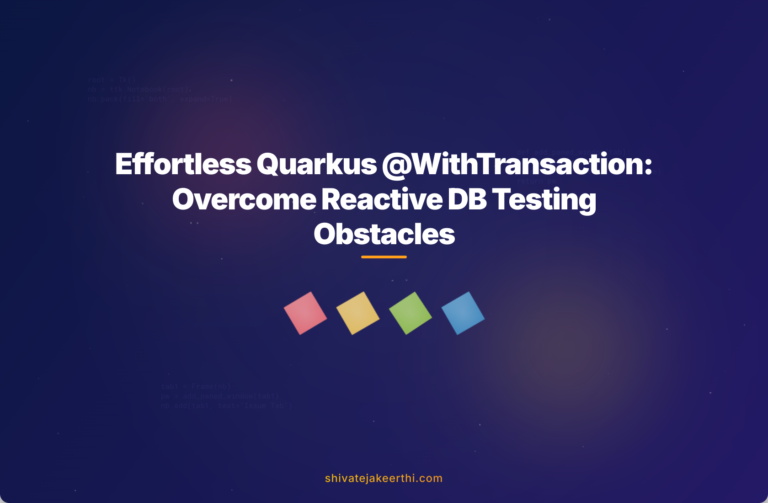When building scalable microservices with Java, Quarkus has quickly become a favorite among developers. Its promise of low memory consumption, lightning-fast startup, and efficient reactive programming through Reactive Panache offers developers the best of both performance and ease of use.
In Quarkus, testing your code is crucial. Unit tests are your first line of defense against regressions. But when you’re dealing with reactive database interactions, specifically methods annotated with @WithTransaction, unit testing isn’t always straightforward.
Let’s unpack this annotation for clarity.
Understanding Quarkus’ @WithTransaction Annotation
In reactive Panache, methods interacting with the database are typically asynchronous. Transactions manage consistency and reliability, which are critical for business logic correctness. The @WithTransaction annotation ensures your method executes within an active database transaction, automatically handling database commits or rollbacks based on success or failure.
Quarkus also provides the annotation @WithSession, which ensures a session context is active during reactive Panache operations. Together, these annotations simplify transaction management and session lifecycles in your Quarkus app, letting you focus on your business logic instead of boilerplate code.
Under the hood, when you annotate a method with @WithTransaction, Quarkus intercepts method calls and opens an active database transaction before your method execution. Upon successful completion, the transaction automatically commits. If an exception occurs, it ensures a proper rollback.
Challenges in Testing @WithTransaction Without a Database
Typically, unit tests should run fast and remain independent of external dependencies like databases. Developers avoid direct database interactions in unit tests, preferring mocks or in-memory solutions.
However, Quarkus’ transactional annotations tightly couple or bind your business logic methods to the active DB connection context. When attempting to call transactional methods without a database, tests usually face these issues:
- Difficulty in mocking DB interactions: Common mocking frameworks like Mockito or Mockito-reactive extensions struggle to effectively mock reactive Panache repositories or database calls when transactions are involved.
- Inability to invoke @WithTransaction methods directly: Attempting to invoke the method directly without a transaction context throws exceptions or errors due to the missing transaction context.
These limitations create barriers in testing transactional methods quickly and effectively.
Exploring Solutions and Common Pitfalls
To navigate this issue, many Quarkus developers experiment with annotations such as @ActivateRequestContext or @RunOnVertxContext, hoping this will magically set up the necessary context. Let’s see their effectiveness:
- @ActivateRequestContext and @RunOnVertxContext: While these annotations help activate request contexts or assurances of running on Vert.x’s reactive thread, they don’t resolve the underlying transactional issue. The transaction context still requires a real or embedded database connection.
- Another attempt can be the usage of @TestReactiveTransaction, which is designed specifically for testing reactive transactional methods. Unfortunately, it still requires a real database to manage the lifecycle, even if it’s embedded. Without a database, tests using this annotation inevitably fail.
Quarkus handles rollbacks implicitly in tests, which demands an active database connection. When there’s no DB connection, it cannot proceed. This is why mocking alone isn’t sufficient.
Can You Ignore or Mock @WithTransaction?
Some developers ask: can we simply “bypass” transaction handling for unit tests?
Technically, @WithTransaction annotations act at runtime, intercepting method calls through built-in transaction interceptors. Currently, there’s no officially supported configuration or annotation in Quarkus to disable these interceptors selectively.
However, you can work around this limitation by carefully structuring your business logic. Consider separating pure business logic methods from transaction-bound methods, ensuring that logic-heavy components remain fully testable independently.
Another common practice involves leveraging embedded databases (like H2 Database or in-memory DBs) specifically for unit tests, reducing complexity and setup overhead. This provides a realistic simulation without external dependencies.
Best Practices for Testing @WithTransaction Methods
To achieve reliable, maintainable tests in Quarkus projects, consider these best practices:
- Separate Business Logic and Persistence Logic:
By isolating business logic into transactional-agnostic service classes or methods, you allow straightforward unit testing without database dependencies. - Use Embedded DBs for Integration Tests:
Consider incorporating embedded or in-memory databases (like H2) to simplify testing and speed up execution times for transaction-dependent tests. - Mock External Dependencies Clearly:
Use mocking frameworks strategically for non-transactional interactions, ensuring simpler isolation of business logic. - Create Clearly Defined Test Suites:
Use separate integration and unit test suites. Integration tests validate transactions, database interactions, and session contexts while unit tests focus purely on logic without DB dependencies.
Here’s an example approach separating transactional logic:
public class TransactionService {
@Inject
Repository repo;
@WithTransaction
public Uni performTransactionalOperation(Entity entity){
return repo.persist(entity);
}
public Uni prepareEntity(Entity entity){
entity.setTimestamp(LocalDateTime.now());
entity.setStatus(Status.NEW);
return Uni.createFrom().item(entity);
}
}
In this example, your prepareEntity() method contains business logic that’s completely testable without trying to mock transactional contexts or persist entities to a DB.
Summary of Challenges and Solutions
Testing @WithTransaction methods in Quarkus without an active database presents genuine challenges. The framework inherently expects an active DB context, requiring real transaction contexts.
Overcoming these challenges involves clear separation of business and persistence logic, carefully structured test strategies, and strategic use of embedded databases, if necessary.
Ultimately, a robust testing approach ensures code reliability, stability, and maintainability—critical qualities in modern, microservice-based Java development with Quarkus.
For integrating Quarkus with frontend development or enhancing your JavaScript skills alongside Quarkus projects, feel free to explore some insightful articles in my JavaScript Articles category.
How do you currently approach testing transactional methods in Quarkus? Let us know your thoughts, challenges, and solutions in the comments below!



0 Comments